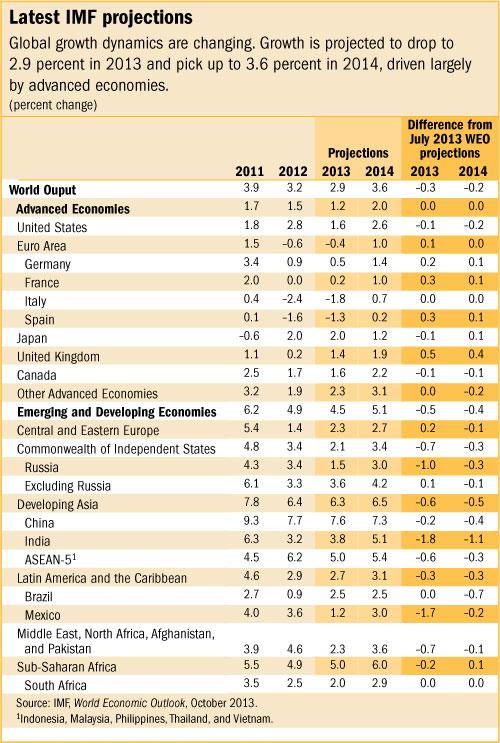
Typical street scene in Santa Ana, El Salvador. (Photo: iStock)
IMF Survey : Global Growth Patterns Shifting, Says IMF WEO
October 8, 2013
- IMF projects global growth at 2.9 percent in 2013, rising to 3.6 percent in 2014
- Growth to be driven more by advanced economies; emerging markets weaker than expected
- Risks to forecast remain on the downside
Global growth is still in low gear and the drivers of growth are shifting, says the IMF’s latest World Economic Outlook (WEO) report. The IMF forecasts global growth to average 2.9 percent in 2013—below the 3.2 percent recorded in 2012—and to rise to 3.6 percent in 2014.

U.S.-produced trucks ready for delivery, in Detroit, Michigan. Much of the pickup in growth in 2014 will be driven by advanced economies (photo: Jeff Haynes/AFP/Getty Images/ Newscom)
WORLD ECONOMIC OUTLOOK
Much of the pickup in growth is expected to be driven by advanced economies. Growth in major emerging markets, although still strong, is expected to be weaker than the IMF forecast in its July 2013 WEO Update. This is partly due to a natural cooling in growth following the stimulus-driven surge in activity after the Great Recession. Structural bottlenecks in infrastructure, labor markets, and investment have also contributed to slowdown in many emerging markets.
“This transition is leading to tensions, with emerging market economies facing both the challenge of slowing growth and changing global financial conditions,” said Olivier Blanchard, the IMF’s chief economist and head of the Research Department.
Indeed, these growth transitions, combined with an approaching turning point in U.S. monetary policy, have led to new challenges and risks. In particular, long-term interest rates in the United States and many other economies have increased more than expected. Although the U.S. Federal Reserve recently decided to not slow the pace of its asset purchases yet and capital outflows from emerging markets have subsided somewhat, bond yields remain well above levels of early May. And there is a distinct risk that financial conditions will tighten from their current, still supportive levels.
• In the United States, the projections are based on the key assumption that the ongoing shutdown in the federal government will be short-lived and the debt ceiling will be raised on time. Growth is expected to rise from 1½ percent this year to 2½ percent in 2014 driven by continued strength in private demand, which is supported by a recovering housing market and rising household wealth.
• In the euro area, policy actions have reduced major risks and stabilized financial conditions, although growth in the periphery is still constrained by credit bottlenecks. The region is expected to gradually pull out of recession, with growth reaching 1 percent in 2014.
• In Japan, fiscal stimulus and monetary easing under the authorities’ new policy package—the so-called Abenomics—has enabled an impressive rebound in activity. But the expected unwinding of fiscal stimulus and reconstruction spending together with consumption tax hikes will lower growth from 2 percent this year to 1¼ percent in 2014.
• In China, growth is projected to decelerate slightly from 7½ percent this year to 7¼ percent in 2014. Policymakers have refrained from stimulating activity amid concerns for financial stability and the need to support a more balanced and sustainable growth path.
• Overall, growth in emerging market and developing economies is expected to remain strong at 4½–5 percent in 2013–14, supported by solid domestic demand, recovering exports, and supportive fiscal, monetary and financial conditions. Commodity prices will continue to boost growth in many low-income countries, including those in sub-Saharan Africa. But economies in the Middle East and North Africa, Afghanistan, and Pakistan region will continue to struggle with difficult economic and political transitions.

Downside risks still dominate
The WEO emphasizes that the changing global growth constellations have exacerbated risks in emerging market economies. Less U.S. monetary policy accommodation combined with domestic vulnerabilities in emerging market economies may lead to further market adjustment globally, with risks of asset price overshooting or even balance of payments disruptions.
Moreover, old risks remain. They include unfinished financial sector reforms in the euro area, impaired monetary policy transmission and corporate debt overhang in some euro area economies, and high government debt and related fiscal and financial risks in many other advanced economies, including Japan and the United States. Geopolitical risks have also resurfaced in recent months.
Even if some of these risks materialized, they would affect all economies through cross-border trade and financial spillovers. So the WEO highlights the risk of the global economy remaining stuck in low gear for a prolonged period.
Policies for more robust and sustainable growth
Pulling the global economy out of a protracted period of subdued economic performance will require, first and foremost, advanced economies to address old challenges, and also emerging market and developing economies to steer through their growth transitions with credible policies.
For advanced economies, the WEO reinforces many of the messages provided in earlier reports. The euro area needs to repair its financial systems and adopt a credible banking union supported by a common backstop. The United States should resolve its political standoff relating to fiscal policy, and promptly raise the debt ceiling. In addition, the Federal Reserve should carefully manage the process of monetary policy normalization, taking into consideration prospects for growth, inflation, and financial conditions. Both Japan and the United States need to accomplish medium-term fiscal adjustment and reform of their social safety net programs. And Japan and the euro area should adopt structural reforms to boost potential output.
The appropriate policy mix and the pace of adjustment will differ across emerging market economies. But many economies share common policy priorities. Policymakers should allow their exchange rates to respond to changes in the environment and act as shock absorbers, while avoiding disorderly market conditions. In economies where monetary policy frameworks are less credible, efforts may need to focus more on providing a strong nominal anchor. Financial regulation and prudential actions should be taken to guard against financial instability. Fiscal adjustment should continue to rebuild buffers, unless downside risks materialize and funding conditions allow fiscal easing.
A new round of structural reforms is a must for many emerging market economies, including investment in infrastructure, to reignite potential growth. China needs to rebalance growth away from investment toward consumption to make way for more balanced and sustainable domestic and global growth.


